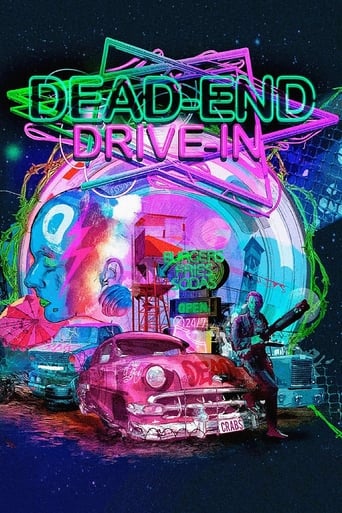There's a party every day, a movie every night, and all the junk food you can eat. What more can a kid want... except to get out.
Un autocine es en realidad, una trampa del Gobierno para atrapar a los revoltosos Car Boys (y demás escoria indeseable) y retenerlos allí. Así la sociedad se verá libre de los jovenes rebeldes que la incordian. Una vez dentro, y mientras completa el acto sexual con su novia, a Crabs le roban las ruedas del coche de su padrastro. El dueño del autocine, el siniestramente anodino señor Thompson, les informa que no hay manera de conseguir otras de recambio. Allí, además, no llegan taxis, autobuses ni se puede comunicar exteriormente con nadie. Van a tener que quedarse pasar la noche. Y pasa la noche y nada cambia, siguen allí. A su alrededor, todos los punks conviven en una especie de autocine fantasmal, con coches que no funcionan y que han sido convertidos en vivientes para sus habitantes. Todos los días comen hamburguesas, huevos y batidos en la cafetería y a las noches pasan una película de ultraviolencia y sadismo. Pero Crabs tiene una idea, y sabe que pueden huir.
"Dead End Drive-In," a dystopian sci-fi film released in 1986, was a collaborative effort between New South Wales Film Corp. and Springvale Productions in Australia. Directed by Brian Trenchard-Smith, the movie presents a grim vision of a future where societal unrest and economic collapse have led to the creation of internment camps disguised as drive-in theaters. The protagonist, Crabs, played by Ned Manning, finds himself trapped in one such facility after dropping off his girlfriend at the aptly named Star Drive-In. As he navigates the harsh realities of life within the camp, the film delves into themes of freedom, control, and the human spirit's resilience. Set against a backdrop of a crumbling society, "Dead End Drive-In" captures the essence of 1980s Australia with its punk aesthetics and rebellious undertones. The film's setting, a dilapidated drive-in theater, serves as a microcosm of the larger societal decay, where the marginalized and forgotten are corralled and controlled. The characters, a mix of societal outcasts and rebels, bring to life the struggle for survival and the yearning for freedom. The film's gritty atmosphere is enhanced by its use of practical effects and real locations, adding a layer of authenticity to the dystopian narrative. Brian Trenchard-Smith's direction brings a raw energy to "Dead End Drive-In," blending elements of action, drama, and social commentary. The film's pacing keeps viewers engaged, as Crabs' journey from naive outsider to determined escapee unfolds. The supporting cast, including notable performances by Natalie McCurry and Peter Whitford, adds depth to the narrative, highlighting the diverse experiences of those trapped within the drive-in. The film's climax, a thrilling escape attempt, underscores the themes of hope and defiance against oppressive systems. "Dead End Drive-In" remains a cult classic, appreciated for its unique take on the dystopian genre and its reflection of societal fears prevalent in 1980s Australia. The collaboration between New South Wales Film Corp. and Springvale Productions resulted in a film that, despite its limited budget, managed to convey powerful messages about freedom and resistance. Its enduring appeal lies in its ability to resonate with audiences who appreciate its blend of social critique and thrilling storytelling, making it a standout in the landscape of Australian cinema.
Año1986
Duración87 minuto
Ver en línea
GénerosTerrorCiencia ficciónAcción
Países de producciónAustralia
